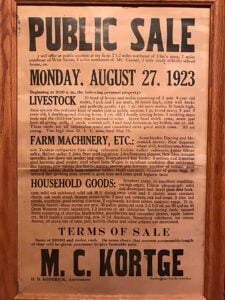 I consider myself a west coast woman. Five of my great-grandparents were born on the west coast (three in Southern California, one in Oregon, and one in Washington). A sixth great-grandparent was born in Ohio, but moved to Southern California as a young boy. As for the final pair of great-grandparents, this year marks the centennial anniversary of their arrival on the West Coast…along with their six biological children, plus my great-grandmother’s first-cousin-once-removed, whom they took in during their first year of marriage.
I consider myself a west coast woman. Five of my great-grandparents were born on the west coast (three in Southern California, one in Oregon, and one in Washington). A sixth great-grandparent was born in Ohio, but moved to Southern California as a young boy. As for the final pair of great-grandparents, this year marks the centennial anniversary of their arrival on the West Coast…along with their six biological children, plus my great-grandmother’s first-cousin-once-removed, whom they took in during their first year of marriage.
Before moving to a farm outside The Dalles, Oregon in the fall of 1923, Mathias and Ellen (Litherland) Kortge had to sell their farm in Illinois, along with pretty much everything on it. They did this by having a public auction on Monday, August 27, 1923—exactly one hundred years ago today! I know this because they kept a copy of the advertising poster printed by the auctioneer.
Many of you likely know the value of finding probate documents which include an inventory of the deceased’s possessions. It’s fascinating to learn what furnishings, books, and even foodstuffs ancestors had on hand when they died. Such documents are not likely to be found for recent ancestors, but the Kortge auction poster serves a similar purpose.
The poster lists the exact location of my great-grandparents’ farm: 2½ miles northeast of Ulm’s store, 7 miles southeast of West Salem, 8 miles northwest of Mt. Carmel, and 1 mile south of Stoltz school. It also lists all kinds of livestock, farm equipment, and household furnishings…and even preserves put up by my beloved “Ma.”
Among the items listed were ten head of horses and mules, including a five-year-old double-gaited driving horse and the children’s “second to none” pony. I was also intrigued by the Acme binder (would Coyote have used such a thing on Roadrunner?), two John Dere [sic] walking plows, a low-down oat seeder, and a “dandy long extension ladder.”
I don’t know whether they replaced all these items in Oregon or not, but they auctioned off a Schubert piano, a cottage organ, an Edison phonograph, lots of solid oak furniture, three iron bedsteads, a sewing machine, a 19-inch German heater, a 9x12 axminister [sic] rug, ten yards of new linoleum, a telephone, and an ice cream freezer. In addition to “lots of cans, jars, kettles, dishes, and other articles not mentioned,” auctiongoers were able to bid on my great-grandmother’s “canned cherries, blackberries, gooseberries and cucumber pickles, apple butter, etc.” I hope those all fetched top dollar, because Ma was a fabulous cook! When she stopped baking pies in her 90s, we were all crestfallen.
Were my great-grandparents striking out for new, unknown lands in 1923? Far from it. In fact, Mat was the last of his mother’s sons to arrive in Wasco County, Oregon. His brother Walt showed up in time for the 1910 census, brother Ray married there in 1916, and baby brother Bill registered there for the draft in 1917. Mat was the last to sell up and join the clan, probably because he was the oldest and had already married and settled into farming by 1907. (An older half-brother lived out his days back in Illinois.)
One of the most charming fruits of this decision is a wonderful photograph of my grandmother, Rachel Kortge, in the midst of her siblings and cousins—at least all those who were born and able to stand by 1925!
Share this:

About Pamela Athearn Filbert
Pamela Athearn Filbert was born in Berkeley, California, but considers herself a “native Oregonian born in exile,” since her maternal great-great-grandparents arrived via the Oregon Trail, and she herself moved to Oregon well before her second birthday. She met her husband (an actual native Oregonian whose parents lived two blocks from hers in Berkeley) in London, England. She holds a B.A. from the University of Oregon, and has worked as a newsletter and book editor in New York City and Salem, Oregon; she was most recently the college and career program coordinator at her local high school.View all posts by Pamela Athearn Filbert →

